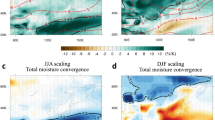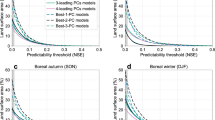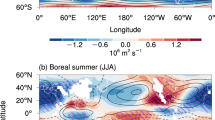Abstract
Future changes in the North American monsoon, a circulation system that brings abundant summer rains to vast areas of the North American Southwest1,2, could have significant consequences for regional water resources3. How this monsoon will change with increasing greenhouse gases, however, remains unclear4,5,6, not least because coarse horizontal resolution and systematic sea-surface temperature biases limit the reliability of its numerical model simulations5,7. Here we investigate the monsoon response to increased atmospheric carbon dioxide (CO2) concentrations using a 50-km-resolution global climate model which features a realistic representation of the monsoon climatology and its synoptic-scale variability8. It is found that the monsoon response to CO2 doubling is sensitive to sea-surface temperature biases. When minimizing these biases, the model projects a robust reduction in monsoonal precipitation over the southwestern United States, contrasting with previous multi-model assessments4,9. Most of this precipitation decline can be attributed to increased atmospheric stability, and hence weakened convection, caused by uniform sea-surface warming. These results suggest improved adaptation measures, particularly water resource planning, will be required to cope with projected reductions in monsoon rainfall in the American Southwest.
This is a preview of subscription content, access via your institution
Access options
Access Nature and 54 other Nature Portfolio journals
Get Nature+, our best-value online-access subscription
$29.99 / 30 days
cancel any time
Subscribe to this journal
Receive 12 print issues and online access
$209.00 per year
only $17.42 per issue
Buy this article
- Purchase on Springer Link
- Instant access to full article PDF
Prices may be subject to local taxes which are calculated during checkout




Similar content being viewed by others
References
Adams, D. K. & Comrie, A. C. The North American monsoon. Bull. Am. Meteorol. Soc. 78, 2197–2213 (1997).
Higgins, R. W., Yao, Y. & Wang, X. L. Influence of the North American monsoon system on the US summer precipitation regime. J. Clim. 10, 298–306 (1997).
Ray, A. J. et al. Applications of monsoon research: opportunities to inform decision making and reduce regional vulnerability. J. Clim. 20, 1608–1627 (2007).
Cook, B. I. & Seager, R. The response of the North American monsoon to increased greenhouse gas forcing. J. Geophys. Res. 118, 1690–1699 (2013).
Bukovsky, M. S. et al. Toward assessing NARCCAP regional climate model credibility for the North American monsoon: future climate simulations. J. Clim. 28, 6707–6728 (2015).
Meyer, J. D. D. & Jin, J. The response of future projections of the North American monsoon when combining dynamical downscaling and bias correction of CCSM4 output. Clim. Dynam. 49, 433–447 (2017).
Geil, K. L., Serra, Y. L. & Zeng, X. Assessment of CMIP5 model simulations of the North American monsoon system. J. Clim. 26, 8787–8801 (2013).
Pascale, S. et al. The Impact of horizontal resolution on North American monsoon Gulf of California moisture surges in a suite of coupled global climate models. J. Clim. 29, 7911–7936 (2016).
Seth, A., Rauscher, S. A., Rojas, M., Giannini, A. & Camargo, S. J. Enhanced spring convective barrier for monsoons in a warmer world? Climatic Change 104, 403–414 (2011).
Maloney, E. D. et al. North American climate in CMIP5 experiments: Part III: assessment of twenty-first-century projections. J. Clim. 27, 2230–2270 (2014).
Seager, R. & Vecchi, G. A. Greenhouse warming and the 21st century hydroclimate of southwestern North America. Proc. Natl Acad. Sci. USA 107, 21277–21282 (2010).
Pascale, S. & Bordoni, S. Tropical and extratropical controls of Gulf of California surges and summertime precipitation over the southwestern United States. Mon. Weath. Rev. 144, 2695–2718 (2016).
Liang, X.-Z., Zhu, J., Kunkel, K. E., Ting, M. & Wang, J. X. L. Do CGCMs simulate the North American monsoon precipitation seasonal-interannual variability? J. Clim. 21, 4424–4448 (2008).
Giannini, A. Mechanisms of climate change in the semiarid African Sahel: the local view. J. Clim. 23, 743–756 (2010).
Lorenz, P. & Jacob, D. Influence of regional scale information on the global circulation: a two-way nesting climate simulation. Geophys. Res. Lett. 32, L18706 (2005).
Wang, C., Zhang, L., Lee, S.-K., Wu, L. & Mechoso, C. R. A global perspective on CMIP5 climate model biases. Nat. Clim. Change 4, 201–205 (2014).
Sutton, R. T. & Hodson, D. L. R. Climate response to basin-scale warming and cooling of the North Atlantic ocean. J. Clim. 20, 891–907 (2006).
Kushnir, Y., Seager, R., Ting, M., Naik, N. & Nakamura, J. Mechanisms of tropical Atlantic SST influence on North American precipitation variability. J. Clim. 23, 5610–5628 (2010).
Delworth, T. L. et al. Simulated climate and climate change in the GFDL CM2.5 high-resolution coupled climate model. J. Clim. 25, 2755–2781 (2012).
Vecchi, G. A. et al. On the seasonal forecasting of regional tropical cyclone activity. J. Clim. 27, 7994–8016 (2014).
Manganello, J. V. & Huang, B. The influence of systematic errors in the Southeast Pacific on ENSO variability and prediction in a coupled GCM. Clim. Dynam. 32, 1015–1034 (2009).
Luong, T. M. et al. The more extreme nature of North American monsoon precipitation in the southwestern US as revealed by a historical climatology of simulated severe weather events. J. Appl. Meteor. Climatol. 56, 2509–2529 (2017).
Randall, D. An Introduction to the Global Circulation of the Atmosphere 456 (Princeton University, 2015).
Mitchell, D. L., Ivanova, D., Rabin, R., Brown, T. J. & Redmond, K. Gulf of California sea surface temperatures and the North American monsoon: mechanistic implications from observations. J. Clim. 15, 2261–2281 (2002).
Xie, S.-P. et al. Global warming pattern formation: sea surface temperature and rainfall. J. Clim. 23, 966–986 (2010).
Chadwick, R. Which aspects of CO2 forcing and SST warming cause most uncertainty in projections of tropical rainfall change over land and ocean? J. Clim. 29, 2493–2509 (2016).
Bony, S. et al. Robust direct effect of carbon dioxide on tropical circulation and regional precipitation. Nat. Geosci. 22, 4213–4227 (2013).
Richardson, T. B., Forster, P. M., Andrews, T. & Parker, D. J. Understanding the rapid precipitation response to CO2 and aerosol forcing on a regional scale. J. Clim. 29, 583–594 (2016).
Zhou, Z.-Q. & Xie, S.-P. Effects of climatological model biases on the projection of tropical climate change. J. Clim. 28, 9909–9917 (2015).
Anderson, B. T., Wang, J., Salvucci, G., Gopal, S. & Islam, S. Observed trends in summertime precipitation over the southwestern United States. J. Clim. 23, 1937–1944 (2010).
Pfahl, S., O’Gorman, P. A. & Fischer, E. M. Understanding the regional pattern of projected future changes in extreme precipitation. Nat. Clim. Change 7, 423–427 (2017).
Kapnick, S. B., Delworth, T. L., Ashfaq, M., Malyshev, S. & Milly, P. C. D. Snowfall less sensitive to warming in Karakoram than in Himalayas due to a unique seasonal cycle. Nat. Geosci. 7, 834–840 (2014).
Delworth, T. L. & Zeng, F. Regional rainfall decline in Australia attributed to anthropogenic greenhouse gases and ozone levels. Nat. Geosci. 7, 583–587 (2014).
Milly, P. C. D. et al. An enhanced model of land water and energy for global hydrologic and earth-system studies. J. Hydrometeor. 15, 1739–1761 (2014).
van der Wiel, K. et al. The resolution dependence of contiguous US precipitation extremes in response to CO2 forcing. J. Clim. 29, 7991–8012 (2016).
Schneider, U. et al. GPCC’s new land surface precipitation climatology based on quality-controlled in situ data and its role in quantifying the global water cycle. Theoret. Appl. Climatol. 115, 15–40 (2013).
Rienecker, M. M. et al. MERRA: NASA’s Modern-Era Retrospective analysis for Research and Applications. J. Clim. 24, 3624–3648 (2011).
Rayner, N. A. et al. Global analyses of sea surface temperature, sea ice, and night marine air temperature since the late nineteenth century. J. Geophys. Res. 108, 4407 (2003).
World Meteorological Organization Technical Regulations Vol. 1, WMO-No. 49 (Geneva, 1988).
Moorthi, S. & Suarez, M. J. Relaxed Arakawa-Schubert: a parameterization of moist convection for general circulation models. Mon. Weath. Rev. 120, 978–1002 (1992).
Acknowledgements
S.P. was supported by the NOAA Climate and Global Change Postdoctoral Fellowship Program, administered by the University Corporation for Atmospheric Research, Boulder, Colorado and by the NOAA CICS grant - NA14OAR4320106. S.B. acknowledges support from the Caltech Davidow Discovery Fund. The authors thank N. Johnson and H. Zhang for comments on the manuscript.
Author information
Authors and Affiliations
Contributions
S.P. designed the research and performed the analysis of the data. S.P. led the writing with the assistance of S.B., S.B.K. and W.R.B. S.P., W.R.B., S.B. and T.L.D. contributed in defining the methods and interpreting the results. All authors took part in the discussion of the results and refined and improved the manuscript. H.M. and G.A.V. designed the model experiments. H.M. and W.Z. performed the simulations.
Corresponding author
Ethics declarations
Competing interests
The authors declare no competing financial interests.
Supplementary information
Supplementary Information
Supplementary Information (PDF 2866 kb)
Rights and permissions
About this article
Cite this article
Pascale, S., Boos, W., Bordoni, S. et al. Weakening of the North American monsoon with global warming. Nature Clim Change 7, 806–812 (2017). https://doi.org/10.1038/nclimate3412
Received:
Accepted:
Published:
Issue Date:
DOI: https://doi.org/10.1038/nclimate3412
This article is cited by
-
Robust changes in global subtropical circulation under greenhouse warming
Nature Communications (2024)
-
The North American Monsoon precipitation response to climate warming at convection-permitting scales
Climate Dynamics (2024)
-
Elevated Grand Canyon groundwater recharge during the warm Early Holocene
Nature Geoscience (2023)
-
Projected increase in summer heat-dome-like stationary waves over Northwestern North America
npj Climate and Atmospheric Science (2023)
-
Enhanced risk of concurrent regional droughts with increased ENSO variability and warming
Nature Climate Change (2022)



